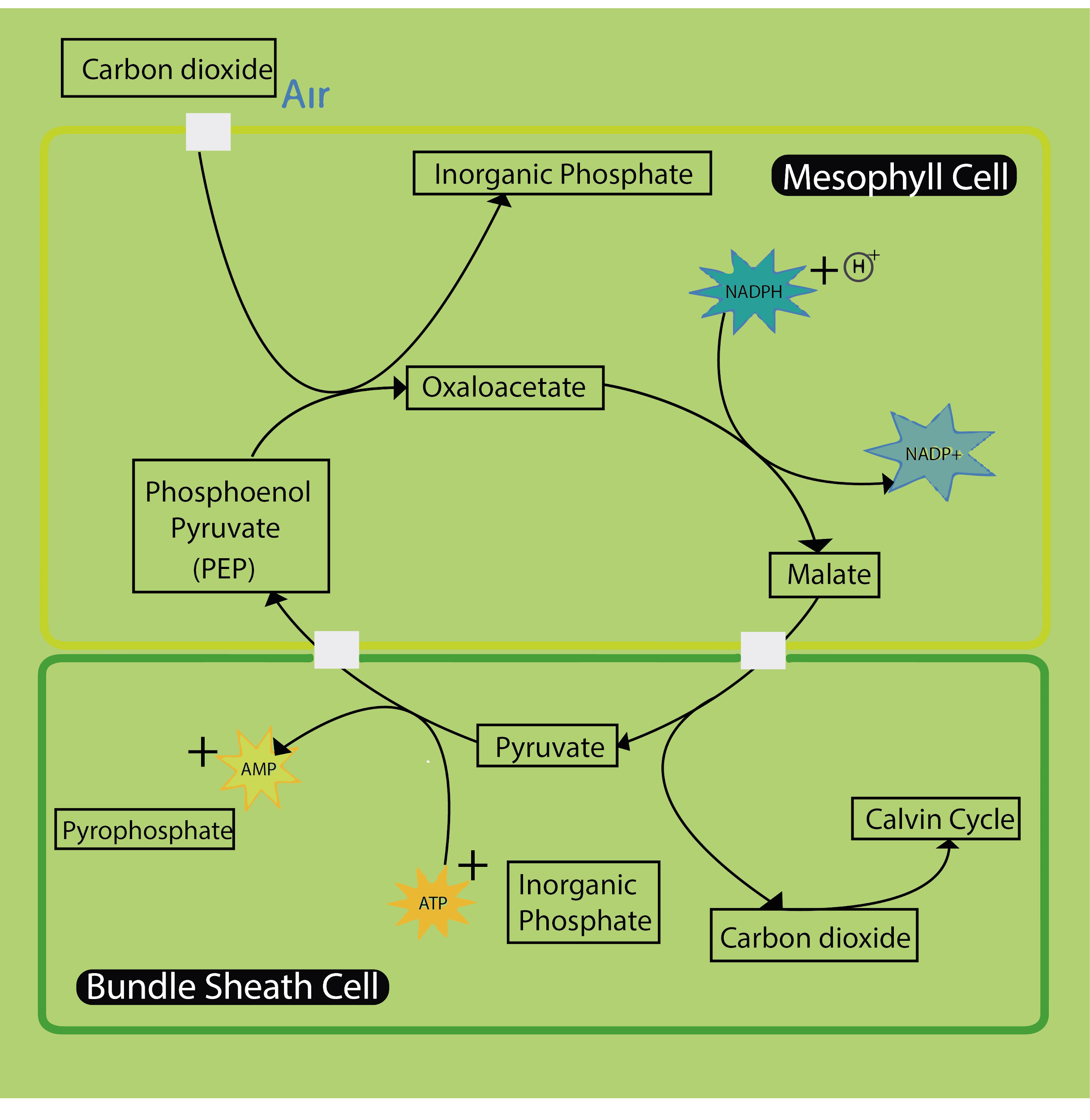
Explain the Hatch-Slack pathway.
Answer
477.3k+ views
Hint: We know that in most of the plants, Oxaloacetic acid which is a 3-carbon containing compound is the first ${ CO }_{ 2 }$ fixation product. But some plants also make use of Phospho-enol pyruvate (PEP) as the first product of ${ CO }_{ 2 }$ fixation which is a 4-carbon containing compound.
Complete answer:
The plants which make use of phospho-enol pyruvate (PEP) as the first product of ${ CO }_{ 2 }$ fixation is called as ${ C }_{ 4 }$ plants as PEP is a 4-carbon containing compound. The ${ C }_{ 4 }$ pathway is also called the Hatch-Slack pathway.
Let us take a look at this pathway step by step:
- First, phospho-enol pyruvate (PEP) which is present in the mesophyll cells accepts ${ CO }_{ 2 }$ under the influence of the enzyme PEP carboxylase. (Mesophyll cells of ${ C }_{ 4 }$ plants lack RuBisCO enzyme and hence the normal pathway with OAA is not used).
- After accepting ${ CO }_{ 2 }$, Malic acid or aspartic acid form in the mesophyll cell itself which are then transported to bundle sheath cells. In bundle sheath cells these acids are broken down in order to release ${ CO }_{ 2 }$ and a 3-carbon molecule.
- This 3-carbon containing molecule is then transported back to mesophyll cells where it again forms PEP and hence one turn of the cycle is completed.
- The ${ CO }_{ 2 }$ which was released in bundle sheath cells participates in the regular ${ C }_{ 3 }$ pathway since these cells are rich in RuBisCO enzyme but they lack PEPcarboxylase.
For better understanding, let us take a look at the diagram below –

Note:
Plants that show ${ C }_{ 4 }$ pathways are called as ${ C }_{ 4 }$ plants are showing a specific type of anatomy in the leaf called Kranz anatomy. They also respond to high light intensities and lack photorespiration.
Complete answer:
The plants which make use of phospho-enol pyruvate (PEP) as the first product of ${ CO }_{ 2 }$ fixation is called as ${ C }_{ 4 }$ plants as PEP is a 4-carbon containing compound. The ${ C }_{ 4 }$ pathway is also called the Hatch-Slack pathway.
Let us take a look at this pathway step by step:
- First, phospho-enol pyruvate (PEP) which is present in the mesophyll cells accepts ${ CO }_{ 2 }$ under the influence of the enzyme PEP carboxylase. (Mesophyll cells of ${ C }_{ 4 }$ plants lack RuBisCO enzyme and hence the normal pathway with OAA is not used).
- After accepting ${ CO }_{ 2 }$, Malic acid or aspartic acid form in the mesophyll cell itself which are then transported to bundle sheath cells. In bundle sheath cells these acids are broken down in order to release ${ CO }_{ 2 }$ and a 3-carbon molecule.
- This 3-carbon containing molecule is then transported back to mesophyll cells where it again forms PEP and hence one turn of the cycle is completed.
- The ${ CO }_{ 2 }$ which was released in bundle sheath cells participates in the regular ${ C }_{ 3 }$ pathway since these cells are rich in RuBisCO enzyme but they lack PEPcarboxylase.
For better understanding, let us take a look at the diagram below –

Note:
Plants that show ${ C }_{ 4 }$ pathways are called as ${ C }_{ 4 }$ plants are showing a specific type of anatomy in the leaf called Kranz anatomy. They also respond to high light intensities and lack photorespiration.
Recently Updated Pages
Oxidation number of N in NH4NO3is A3 B+5 C3 and +5 class 11 chemistry CBSE

Write the main reasons for the stability of colloidal class 11 chemistry CBSE

One difference between a Formal Letter and an informal class null english null

Class 11 Question and Answer - Your Ultimate Solutions Guide

Master Class 11 Business Studies: Engaging Questions & Answers for Success

Master Class 11 Accountancy: Engaging Questions & Answers for Success

Trending doubts
The reservoir of dam is called Govind Sagar A Jayakwadi class 11 social science CBSE

What problem did Carter face when he reached the mummy class 11 english CBSE

Proton was discovered by A Thomson B Rutherford C Chadwick class 11 chemistry CBSE

In China rose the flowers are A Zygomorphic epigynous class 11 biology CBSE

What is Environment class 11 chemistry CBSE

Nucleolus is present in which part of the cell class 11 biology CBSE




